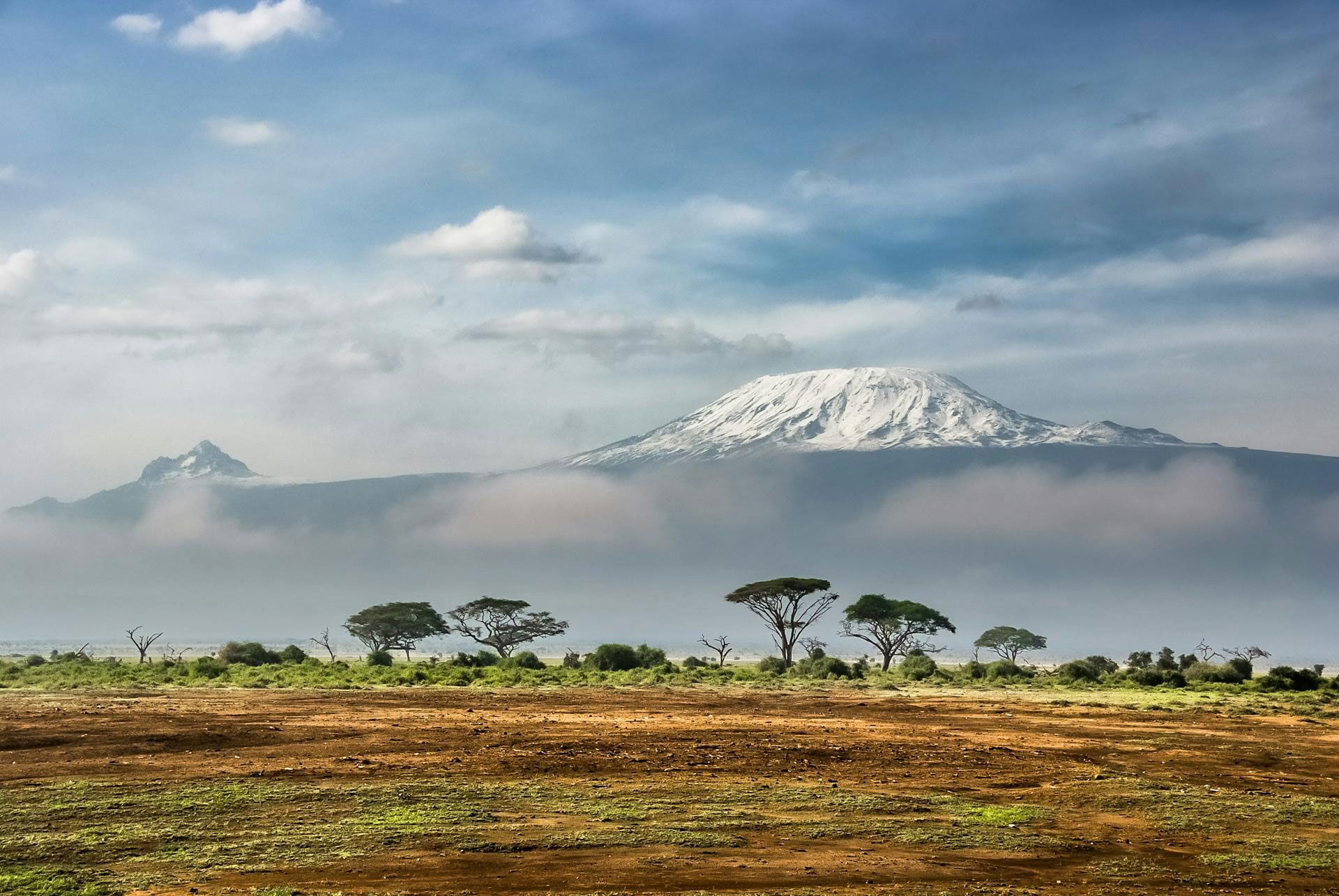
Climbing Kilimanjaro: Essential Tips for a Successful Summit
18 min readStanding at 5,895 meters above sea level, Mount Kilimanjaro represents the ultimate African adventure - a non-technical climb that challenges your endurance while rewarding you with breathtaking views across the continent. Unlike many of the world's highest peaks, Kilimanjaro requires no mountaineering experience, making it accessible to determined hikers with proper preparation. However, this accessibility shouldn't fool you into underestimating the mountain's demands.
Every year, thousands of adventurers attempt to reach Uhuru Peak, yet summit success rates vary dramatically based on preparation, route choice, and understanding of high-altitude challenges. Whether you're an experienced hiker seeking your next challenge or an adventure enthusiast ready to tackle your first major mountain, success on Kilimanjaro depends on thorough planning, physical preparation, and respect for the mountain's unique environment. This comprehensive guide provides the essential knowledge you need to maximize your chances of standing atop Africa's roof while ensuring a safe and memorable experience.
Kilimanjaro Climbing Guide
- Understanding Kilimanjaro: Africa's Majestic Giant
- The Mountain's Unique Geography
- Climate and Weather Patterns
- Route Selection: Choosing Your Path to the Summit
- The Seven Kilimanjaro Routes
- Factors Influencing Route Choice
- Physical Training and Preparation
- Building Cardiovascular Endurance
- Strength and Conditioning
- Mental Preparation
- Essential Gear and Equipment
- Layering System Fundamentals
- Footwear and Sock Systems
- Backpack and Organization
- Technology and Safety Equipment
- Altitude Acclimatization Strategies
- Understanding Altitude Physiology
- Acclimatization Techniques
- Recognizing Altitude-Related Illness
- Prevention Strategies
- Safety Considerations and Risk Management
- Guide and Porter Selection
- Emergency Preparedness
- Personal Safety Protocols
- Nutrition and Hydration Strategies
- Fueling Your Ascent
- Hydration Management
- Meal Planning and Food Safety
- Mental Strategies for Summit Success
- Psychological Preparation
- Coping with Adversity
- Summit Day Psychology
- Planning Your Kilimanjaro Adventure
- Selecting Tour Operators
- Timing and Logistics
- Budgeting and Value Considerations
- FAQ: Your Kilimanjaro Questions Answered
Understanding Kilimanjaro: Africa's Majestic Giant
The Mountain's Unique Geography
Mount Kilimanjaro stands as a massive stratovolcano in northern Tanzania, near the Kenyan border. This iconic mountain consists of three volcanic cones: Kibo (the highest), Mawenzi, and Shira. What makes Kilimanjaro particularly remarkable is its dramatic ecological zones, which change as dramatically as traveling from the equator to the Arctic.
The mountain's base begins in cultivated farmland at approximately 1,000 meters, progressing through montane forest, heath and moorland, alpine desert, and finally arctic conditions at the summit. This diversity means climbers experience multiple ecosystems during their ascent, each presenting different challenges and spectacular scenery.

Kilimanjaro's Ecological Zones: The lower slopes feature lush rainforest with diverse wildlife including colobus monkeys and exotic bird species. As elevation increases, vegetation becomes sparse, transitioning into heath characterized by giant groundsels and lobelias. The alpine desert zone presents a stark, otherworldly landscape before reaching the glaciated summit area.
Understanding these zones helps climbers prepare appropriate gear and manage expectations about changing conditions during the ascent.
Climate and Weather Patterns
Kilimanjaro's proximity to the equator creates relatively stable weather patterns, though conditions vary significantly with altitude. The mountain experiences two main climbing seasons, each offering distinct advantages for different types of climbers.
Dry Seasons: The primary climbing season runs from late June through October, offering generally clear skies and stable weather conditions. This period typically provides the best visibility and most comfortable camping conditions, though temperatures still drop significantly at higher elevations.
The secondary season from late December through March also offers excellent climbing conditions, often with fewer crowds than the main season. This period can provide spectacular clear weather, particularly in January and February.
Rainy Seasons: The long rains (March through May) and short rains (November through early December) present challenging conditions with increased precipitation and reduced visibility. However, some experienced climbers prefer these periods for fewer crowds and lush lower-zone scenery.

Weather Tip
Temperature variations are extreme, ranging from tropical warmth at the base to sub-zero conditions at the summit. Climbers must prepare for temperature swings of over 40 degrees Celsius during the ascent.
Route Selection: Choosing Your Path to the Summit
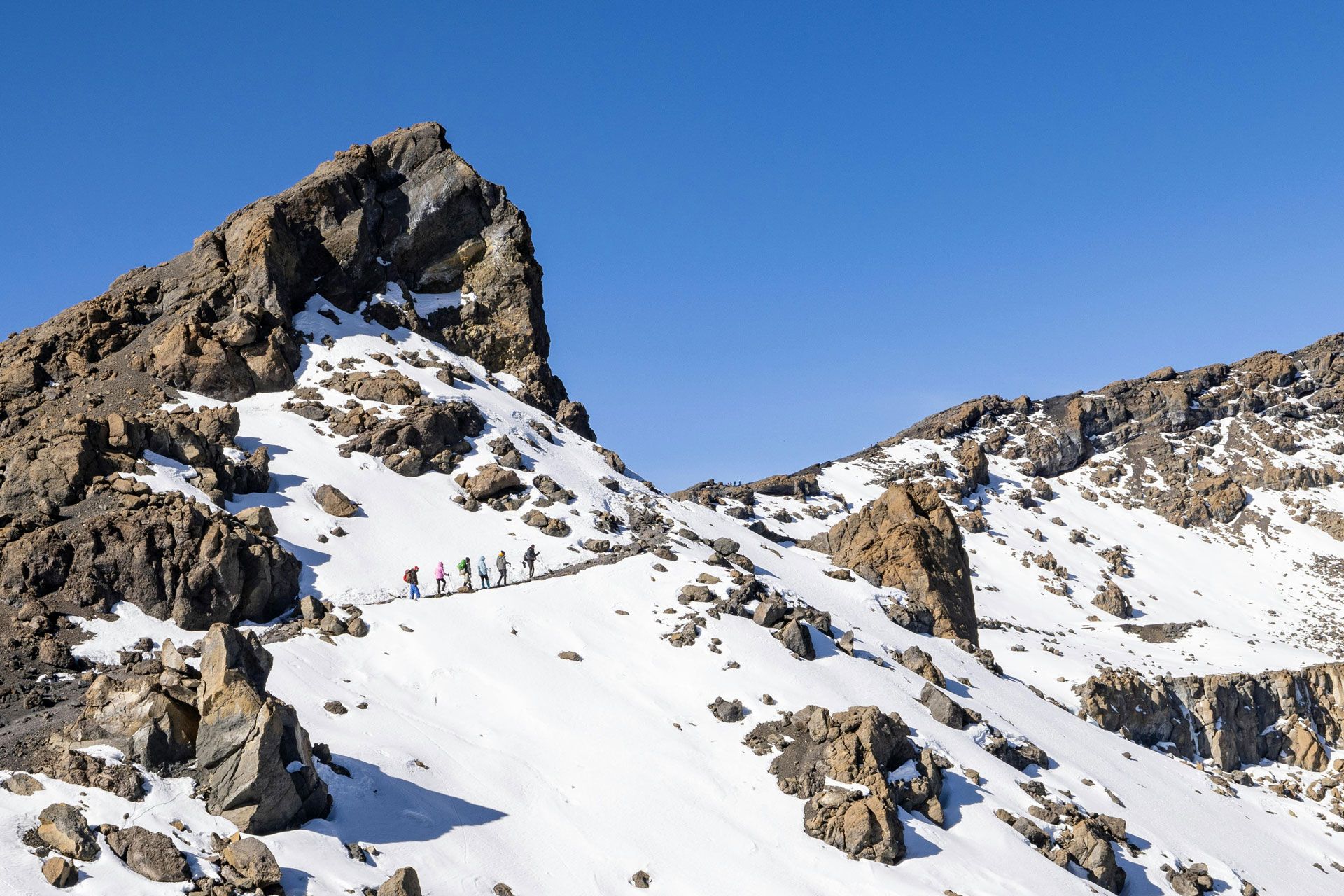
The Seven Kilimanjaro Routes
Kilimanjaro offers seven established routes, each providing different experiences, difficulty levels, and success rates. Understanding route characteristics helps climbers choose the path best suited to their experience level, time constraints, and preferences.
Machame Route ("Whiskey Route"): Often considered the most scenic route, Machame typically takes 6-7 days and offers excellent acclimatization opportunities. The route approaches from the southwest, providing diverse landscapes and high summit success rates. However, its popularity means more crowded trails and campsites.
The Machame route includes the challenging Barranco Wall scramble, which requires basic rock scrambling skills but adds adventure to the climb. This route offers multiple "climb high, sleep low" opportunities that enhance acclimatization.
Marangu Route ("Coca-Cola Route"): The only route offering hut accommodation instead of camping, Marangu provides more comfortable sleeping arrangements but fewer acclimatization opportunities due to its shorter 5-6 day itinerary. While often marketed as easier, the rapid ascent profile actually results in lower success rates compared to longer routes.
Marangu's hut system provides protection from weather but creates crowded conditions during peak seasons. The route ascends and descends via the same path, offering less scenic variety than circuit routes.
Lemosho Route: Considered one of the most beautiful approaches, Lemosho begins on Kilimanjaro's western slopes and joins the Machame route on day 3. This 7-8 day route offers excellent acclimatization and lower crowd levels during initial days.
Lemosho provides spectacular views across to Mount Meru and the Kenyan plains while offering gradual altitude gain that enhances summit success rates.
Rongai Route: The only northern approach, Rongai offers a different perspective of the mountain with generally drier conditions due to its rain shadow location. This 6-7 day route provides good wildlife viewing opportunities and fewer crowds but less scenic diversity compared to western routes.
Rongai's gentler gradient makes it suitable for less experienced hikers, though its approach angle provides fewer natural acclimatization opportunities.
Northern Circuit: The longest route at 8-9 days, the Northern Circuit provides the highest summit success rates due to excellent acclimatization opportunities. This route circles around the northern slopes before ascending via the Rongai path, offering spectacular 360-degree mountain views.
While more expensive due to additional days, the Northern Circuit provides the best combination of scenery, acclimatization, and summit success for those with adequate time and budget.
Umbwe and Shira Routes: These shorter, more challenging routes are typically recommended only for experienced climbers with previous high-altitude experience. Both offer steep ascent profiles that require excellent fitness and natural altitude tolerance.
Factors Influencing Route Choice
Physical Fitness Level: Routes like Machame and Lemosho require good physical fitness due to longer daily hiking distances and elevation gains. Marangu offers shorter daily distances but provides less acclimatization time.
Previous Altitude Experience: Climbers with high-altitude experience might consider shorter routes, while first-time high-altitude climbers benefit from longer itineraries that allow gradual adaptation.
Time Availability: Available vacation time significantly influences route choice, with options ranging from 5-day Marangu to 9-day Northern Circuit experiences.
Budget Considerations: Longer routes require additional park fees, porter wages, and equipment rental, significantly impacting total costs.
Comfort Preferences: Hut accommodation on Marangu versus camping on other routes represents a significant comfort and experience difference that influences route selection.
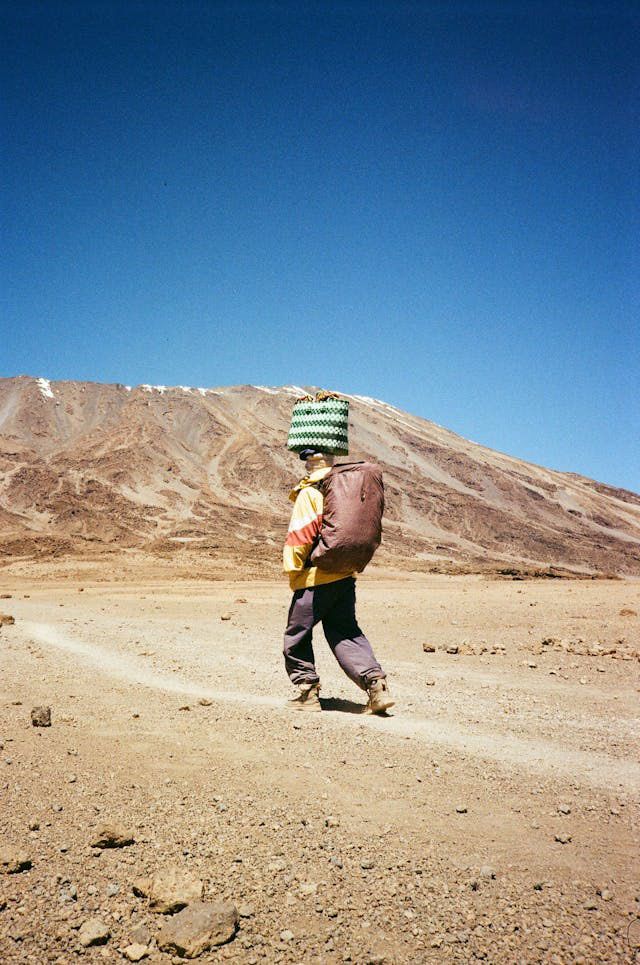

Physical Training and Preparation
Building Cardiovascular Endurance
Successful Kilimanjaro climbing requires exceptional cardiovascular fitness to handle long hiking days at progressively higher altitudes. Training should begin minimum 3-4 months before departure, focusing on building aerobic capacity and hiking-specific strength.
Cardiovascular Training Program: Begin with 30-45 minute sessions of moderate-intensity cardio activities like running, cycling, or swimming 4-5 times weekly. Gradually increase duration and intensity, building toward 60-90 minute sessions that simulate long hiking days.
Incorporate interval training to improve both aerobic and anaerobic capacity. Hill repeats and stair climbing specifically prepare leg muscles for sustained uphill hiking while building cardiovascular efficiency.
Long weekend hikes with loaded backpacks provide the most specific training, gradually increasing distance and elevation gain. Aim to comfortably complete 6-8 hour hikes carrying 10-15 kg backpacks before departure.
Altitude Training Considerations: While true altitude training requires access to high elevations, activities that improve oxygen efficiency help preparation. Swimming, which naturally restricts breathing, and interval training both enhance oxygen utilization efficiency.
Some climbers use altitude training masks or hypoxic chambers, though scientific evidence regarding their effectiveness remains mixed. [Verify current sports science recommendations on altitude training aids]
Strength and Conditioning
Kilimanjaro's extended hiking days demand specific muscular endurance, particularly in legs, core, and stabilizing muscles. Strength training should complement cardiovascular preparation without building excessive muscle bulk.
Lower Body Strength: Focus on functional exercises like squats, lunges, step-ups, and calf raises that simulate hiking movements. Single-leg exercises improve balance and address muscle imbalances that could cause injury during long hiking days.
Plyometric exercises like box jumps and lateral bounds develop power and stability needed for uneven terrain navigation.
Core Stability: Strong core muscles support heavy backpack loads and maintain balance on challenging terrain. Planks, side planks, and rotational exercises build functional core strength relevant to hiking demands.
Flexibility and Mobility: Regular stretching and yoga practice maintain flexibility while preventing injury. Focus on hip flexors, hamstrings, calves, and ankle mobility that directly impact hiking comfort and efficiency.
Mental Preparation
Physical fitness alone doesn't guarantee summit success - mental preparation proves equally important for handling Kilimanjaro's psychological challenges.
Developing Mental Resilience: Practice positive self-talk and visualization techniques that help manage difficult moments during the climb. Mental training should include strategies for handling fatigue, discomfort, and altitude-related challenges.
Study accounts from successful climbers to understand common psychological challenges and effective coping strategies. Understanding that temporary discomfort leads to extraordinary achievement helps maintain motivation during difficult moments.
Goal Setting and Expectation Management: Set realistic intermediate goals beyond just reaching the summit. Celebrating daily achievements and appreciating the journey helps maintain positive mindset regardless of ultimate summit success.
Essential Gear and Equipment
Layering System Fundamentals
Kilimanjaro's extreme temperature variations require a sophisticated layering system that adapts to changing conditions throughout the climb. Understanding layering principles helps climbers stay comfortable and safe across all ecological zones.
Base Layer Requirements: Moisture-wicking synthetic or merino wool base layers provide foundation comfort during active climbing. Avoid cotton materials that retain moisture and lose insulating properties when wet.
Pack multiple base layer options including lightweight shirts for warm lower zones and heavyweight tops for cold high-altitude conditions.
Insulation Layer Options: Down or synthetic insulation jackets provide warmth during rest stops and cold evening conditions. Down offers superior warmth-to-weight ratios but loses insulating properties if wet, while synthetic insulation maintains warmth when damp.
Fleece jackets provide versatile mid-layer options that balance warmth, breathability, and moisture management during active climbing.
Shell Layer Protection: Waterproof, breathable shell jackets and pants protect against wind and precipitation while allowing moisture escape during active climbing. Quality shell garments prove essential for summit day conditions where wind and potential snow create challenging environments.
Footwear and Sock Systems
Proper footwear selection significantly impacts comfort and safety throughout the climb. Kilimanjaro's varied terrain demands versatile, well-fitted boots that handle everything from muddy forest paths to rocky alpine terrain.
Boot Requirements: Sturdy, waterproof hiking boots with ankle support prove essential for Kilimanjaro's challenging terrain. Boots should be broken in thoroughly before departure to prevent blisters and pressure points during long hiking days.
Consider insulated boots for summit attempts, as standard hiking boots may prove insufficient for sub-zero summit conditions.
Sock System Strategy: Quality wool or synthetic hiking socks prevent blisters while managing moisture during long hiking days. Liner socks combined with hiking socks create systems that reduce friction and hot spots.
Pack multiple sock pairs to maintain dry feet throughout the climb, as wet feet dramatically increase blister risk and discomfort.
Gaiters and Foot Protection: Gaiters prevent sand, rocks, and moisture from entering boots while providing additional lower leg protection. This simple addition significantly improves comfort on Kilimanjaro's dusty and rocky terrain.
Backpack and Organization
Efficient packing and organization systems improve hiking comfort while ensuring essential items remain accessible during changing conditions.
Backpack Selection: 40-50 liter backpacks typically provide adequate capacity for day hiking needs while porters carry overnight equipment. Choose packs with comfortable hip belts and load distribution systems that handle daily hiking loads effectively.
Internal organization systems with multiple compartments help maintain gear organization and quick access to frequently needed items.
Packing Strategies: Use waterproof stuff sacks and dry bags to organize gear while protecting items from moisture. Group similar items together for efficient packing and easy access during the climb.
Keep essential items like rain gear, snacks, water, and medications easily accessible in external pockets or pack tops.
Technology and Safety Equipment
Modern technology can enhance safety and enjoyment while climbing Kilimanjaro, though reliability in harsh conditions requires careful equipment selection.
Navigation and Communication: GPS devices or smartphone apps provide backup navigation, though guides typically handle route finding. Emergency communication devices like satellite messengers offer safety backup in remote areas.
Photography Equipment: Camera protection becomes critical in Kilimanjaro's dusty and potentially wet conditions. Lens filters and protective cases ensure equipment functionality throughout the climb.
Extra batteries prove essential as cold temperatures dramatically reduce battery life at high altitudes.
Personal Safety Items: Headlamps with backup batteries enable safe movement during early morning summit attempts and evening camp activities. Quality sunglasses protect against intense high-altitude UV exposure and potential snow glare.
Sunscreen with high SPF ratings prevents severe sunburn in thin atmosphere conditions where UV intensity increases dramatically.
Altitude Acclimatization Strategies
Understanding Altitude Physiology
Successful Kilimanjaro climbing requires understanding how the human body responds to decreasing oxygen levels at high altitude. This knowledge helps climbers recognize normal adaptation processes versus concerning altitude-related symptoms.
Physiological Adaptation Process: As altitude increases, atmospheric pressure decreases, reducing oxygen availability in each breath. The body responds by increasing breathing rate, heart rate, and red blood cell production over time.
Initial adaptation occurs within 24-48 hours, but full acclimatization to high altitudes requires weeks. Kilimanjaro climbs compress this timeline, making proper acclimatization strategies critical for success and safety.
Normal Adaptation Symptoms: Mild headaches, slight nausea, and sleep disturbances represent normal responses to altitude exposure. These symptoms typically improve within 1-2 days as the body adapts to reduced oxygen levels.
Increased urination and periodic breathing during sleep are also common responses that generally don't indicate serious problems.
Acclimatization Techniques
"Climb High, Sleep Low" Strategy: This fundamental mountaineering principle involves hiking to higher elevations during the day while sleeping at lower altitudes. This approach stimulates physiological adaptation while allowing recovery at more comfortable elevations.
Routes like Machame and Lemosho naturally incorporate this strategy through their routing and camp placement, contributing to higher success rates.
Gradual Ascent Profiles: Avoid rapid altitude gains that outpace the body's adaptation capabilities. Generally, climbers should not sleep more than 300-500 meters higher each night above 3,000 meters elevation.
Longer routes provide more gradual ascent profiles that allow natural acclimatization, explaining their higher summit success rates compared to shorter itineraries.
Hydration and Nutrition: Proper hydration supports acclimatization by maintaining blood volume and facilitating physiological adaptation processes. Aim for clear or light yellow urine as hydration indicators.
Carbohydrate-rich diets provide easily accessible energy while supporting the body's increased metabolic demands at altitude.
Recognizing Altitude-Related Illness
Acute Mountain Sickness (AMS): AMS presents with headache, nausea, fatigue, and dizziness that persist or worsen over time. While uncomfortable, mild AMS doesn't necessarily require descent if symptoms remain stable or improve.
Monitor symptoms carefully and be prepared to descend if conditions worsen despite rest and conservative treatment.
High Altitude Cerebral Edema (HACE): HACE represents a medical emergency characterized by confusion, loss of coordination, and altered consciousness. This condition requires immediate descent and medical attention.
High Altitude Pulmonary Edema (HAPE): HAPE involves fluid accumulation in the lungs, causing severe shortness of breath, coughing, and decreased exercise capacity. Like HACE, this condition demands immediate descent and medical evaluation.
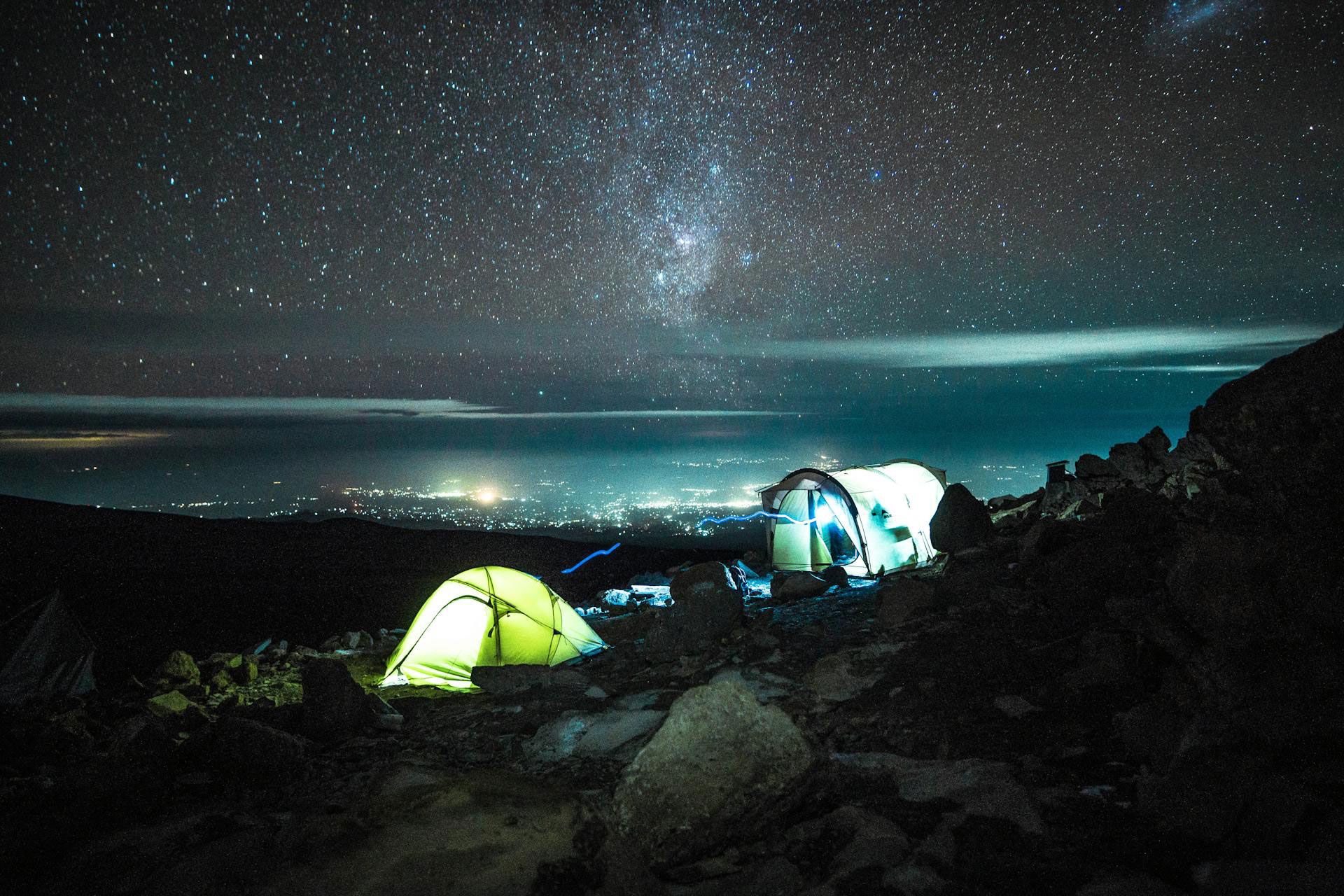
Prevention Strategies
Pre-Acclimatization Options: Some climbers spend time at moderate altitudes before arriving in Tanzania to begin adaptation processes. Locations above 2,500 meters can provide beneficial pre-acclimatization for those with access to such elevations.
Medication Considerations: Acetazolamide (Diamox) can aid acclimatization by stimulating breathing and reducing sleep disturbances. However, this medication requires consultation with healthcare providers familiar with altitude medicine. [Always verify current medical recommendations and consult healthcare providers]
Conservative Climbing Philosophy: Maintain flexible itineraries that allow extra acclimatization days if needed. Pushing upward despite concerning symptoms leads to decreased summit success and potential medical emergencies.
Safety Considerations and Risk Management
Guide and Porter Selection
Professional guide services significantly impact both safety and success rates on Kilimanjaro. Understanding how to evaluate guide qualifications helps ensure positive climbing experiences.
Guide Qualifications and Experience: Licensed Kilimanjaro guides complete formal training programs covering mountain safety, first aid, and route knowledge. Experienced guides recognize altitude illness symptoms and make appropriate safety decisions based on changing conditions.
Ask about guide experience levels, safety training certifications, and emergency evacuation procedures before booking climbing services.
Porter Treatment and Ethics: Ethical climbing operations ensure porters receive fair wages, appropriate equipment, and reasonable load limits. Organizations like the Kilimanjaro Porters Assistance Project promote responsible porter treatment standards.
Choose operators committed to porter welfare, as ethical treatment typically correlates with overall service quality and safety standards.
Guide-to-Climber Ratios: Appropriate guide ratios ensure adequate supervision and safety oversight during challenging sections. Ratios of 1:2 for guides and 1:3-4 for assistant guides provide good safety margins while maintaining personalized attention.
Emergency Preparedness
Communication and Evacuation Plans: Understanding emergency communication procedures and evacuation capabilities provides peace of mind while climbing. Most professional operations maintain radio contact with base operations and evacuation services.
Emergency evacuation insurance covering high-altitude rescue operations proves essential, as evacuation costs can exceed tens of thousands of dollars. [Always verify current insurance coverage requirements]
Medical Preparation: Comprehensive medical kits should include altitude illness medications, pain relievers, anti-diarrheal medications, and basic first aid supplies. Prescription medications require adequate supplies plus extras for potential delays.
Climbers with pre-existing medical conditions should consult physicians familiar with high-altitude medicine before attempting Kilimanjaro.
Weather-Related Risks: Kilimanjaro's weather can change rapidly, creating challenging conditions even during favorable seasons. Quality gear and conservative decision-making help manage weather-related risks effectively.
Lightning represents a significant hazard during afternoon thunderstorms in lower zones. Early morning starts help avoid afternoon weather development patterns.
Personal Safety Protocols
Hydration and Nutrition Management: Dehydration and inadequate nutrition compromise both performance and safety at altitude. Maintain consistent eating and drinking schedules even when appetite decreases at higher elevations.
Water purification methods ensure safe drinking water throughout the climb, as waterborne illnesses can quickly compromise climbing safety and success.
Sun Protection: Intense UV radiation at high altitudes causes severe sunburn and snow blindness if adequate protection isn't maintained. Quality sunglasses, sunscreen, and protective clothing prevent serious sun-related injuries.
High-altitude environments reflect UV radiation from snow and rocky surfaces, increasing exposure from multiple angles.
Nutrition and Hydration Strategies
Fueling Your Ascent
Proper nutrition becomes increasingly challenging yet more critical as altitude increases and appetite decreases. Understanding nutritional needs helps maintain energy levels throughout the climb.
Caloric Requirements: Kilimanjaro climbing typically burns 3,000-5,000 calories daily, significantly exceeding normal daily requirements. Cold conditions and altitude exposure further increase metabolic demands.
Focus on calorie-dense foods that provide sustained energy while remaining palatable at altitude where appetite often diminishes.
Macronutrient Balance: Carbohydrates provide easily accessible energy for sustained hiking efforts. Simple carbohydrates offer quick energy during active climbing, while complex carbohydrates provide sustained fuel.
Adequate protein supports muscle recovery during multi-day climbing efforts. Fats provide concentrated energy and help with satiety during long hiking days.
High-Altitude Eating Strategies: Appetite typically decreases at altitude, making frequent small meals more effective than large portions. Focus on familiar, palatable foods that remain appealing even when feeling mildly nauseous.
Sweet foods often remain appealing at altitude when other flavors become unappealing. Pack favorite snacks and comfort foods that provide psychological as well as physical benefits.
Hydration Management
Daily Fluid Requirements: High altitude, dry air, and increased breathing rates dramatically increase fluid needs. Aim for 3-4 liters of fluid daily, monitoring urine color as hydration indicators.
Begin each day well-hydrated and maintain consistent fluid intake throughout hiking and rest periods.
Electrolyte Balance: Extended sweating and increased urination at altitude deplete electrolytes that require replacement. Electrolyte supplements or sports drinks help maintain proper mineral balance.
Avoid excessive plain water consumption that can dilute blood sodium levels, creating potentially dangerous hyponatremia conditions.
Water Source Management: Reliable water sources exist along most Kilimanjaro routes, but purification remains essential for safety. Boiling, filtration, or chemical treatment ensures safe drinking water throughout the climb.
In cold conditions, prevent water bottles from freezing by keeping them inside sleeping bags overnight or using insulated bottle covers.
Meal Planning and Food Safety
Operator-Provided Meals: Most Kilimanjaro operators provide comprehensive meal services featuring local ingredients and international cuisine adaptations. Discuss dietary restrictions and preferences during booking to ensure appropriate meal planning.
Supplemental Snacks: Personal snack supplies provide backup nutrition and familiar comfort foods during challenging moments. Energy bars, nuts, dried fruits, and chocolate offer portable, calorie-dense options.
Food Safety Considerations: Altitude and camping conditions increase food safety risks that can cause serious gastrointestinal illness during critical climbing periods. Choose operators with strong food safety protocols and proper food storage practices.
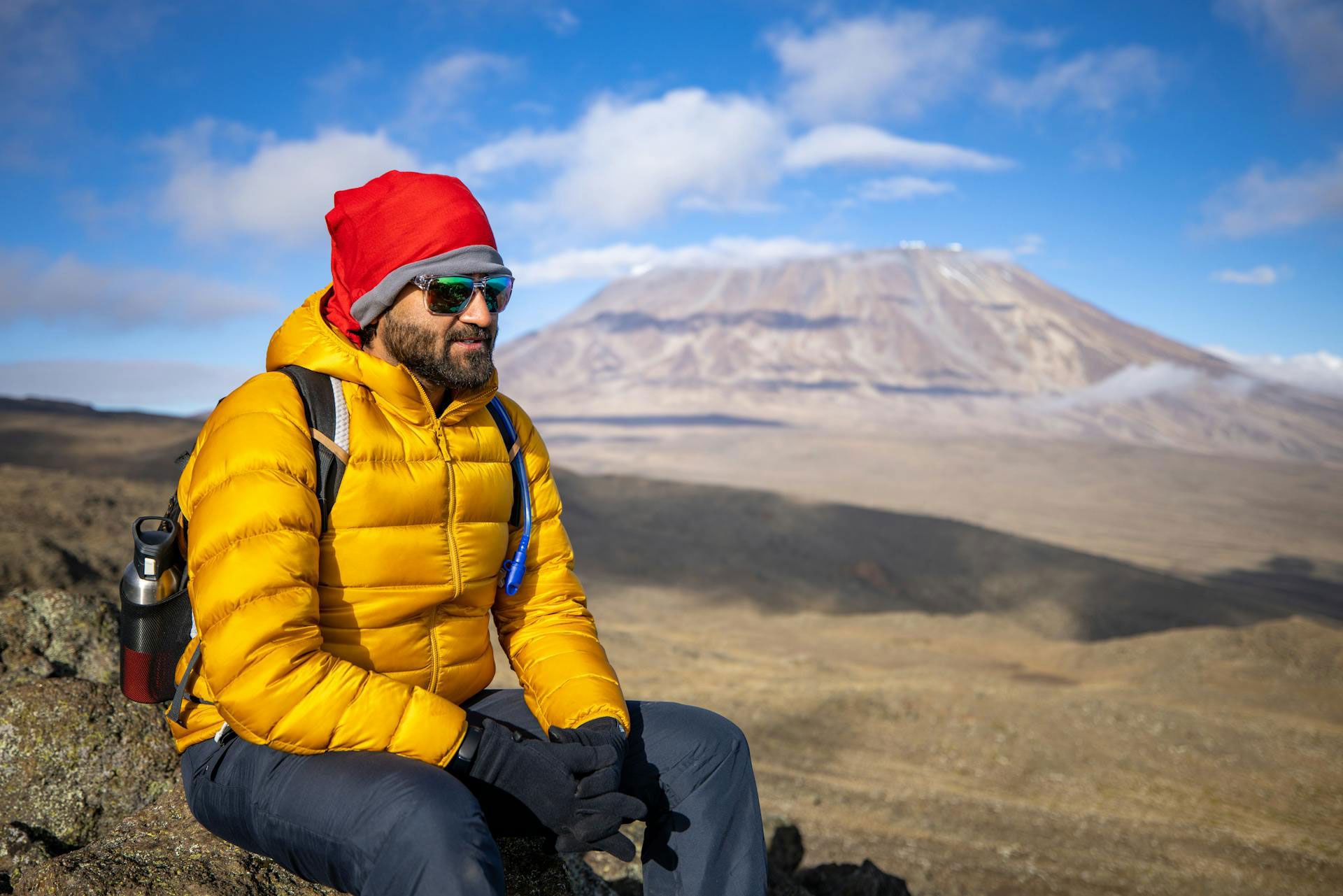
Mental Strategies for Summit Success
Psychological Preparation
Mental fortitude often determines summit success more than physical capabilities. Developing psychological strategies helps climbers push through challenging moments that inevitably arise during multi-day high-altitude climbing.
Expectation Management: Understanding that discomfort, fatigue, and temporary setbacks represent normal parts of the Kilimanjaro experience helps maintain perspective during difficult moments. Mental preparation should include strategies for handling both physical and emotional challenges.
Focus on process goals rather than just outcome goals. Celebrating daily achievements and appreciating unique experiences helps maintain positive mindset regardless of ultimate summit success.
Motivation Techniques: Develop personal motivation strategies that resonate during challenging moments. These might include dedicating the climb to meaningful causes, carrying symbolic items, or visualizing successful completion.
Understanding your personal "why" for attempting Kilimanjaro provides powerful motivation during inevitable difficult moments when physical discomfort and fatigue challenge your resolve.
Coping with Adversity
Managing Discomfort: Accept that temporary discomfort represents a normal part of high-altitude climbing rather than signs of failure or inadequate preparation. Developing comfort with discomfort enhances mental resilience during challenging climbing phases.
Break large challenges into smaller, manageable segments. Focus on reaching the next rest stop rather than dwelling on remaining distance to camps or summit.
Team Dynamics: Positive group dynamics significantly impact individual experiences and success rates. Support fellow climbers during their challenging moments while accepting help during your own difficult periods.
Maintain encouraging communication and avoid negative expressions that could undermine group morale during stressful situations.
Dealing with Setbacks: Weather delays, route changes, or health issues may require itinerary modifications that initially seem disappointing. Mental flexibility and adaptation to changing circumstances often determine overall climb satisfaction.
View setbacks as part of the adventure rather than failures, maintaining focus on aspects of the experience within your control.
Summit Day Psychology
Managing Summit Day Pressure: Summit day represents the culmination of extensive preparation and multi-day effort, creating psychological pressure that can negatively impact performance. Treat summit day as one step in a longer journey rather than the sole measure of success.
Focus on process elements like maintaining steady pace, proper hydration, and positive attitude rather than fixating on reaching the summit at any cost.
Decision-Making Under Stress: Altitude, fatigue, and cold conditions impair judgment during critical decision-making moments. Establish decision-making criteria before summit attempts and trust guide expertise during challenging conditions.
Recognize that turning back represents responsible mountaineering rather than failure when conditions or personal health warrant conservative decisions.
Planning Your Kilimanjaro Adventure
Selecting Tour Operators
Choosing the right climbing operator significantly impacts safety, success rates, and overall experience quality. Understanding evaluation criteria helps identify operators that align with your priorities and standards.
Safety Standards and Certifications: Research operator safety records, guide training standards, and emergency evacuation procedures. Reputable operators maintain comprehensive insurance coverage and established emergency protocols.
Look for operators that limit group sizes, maintain appropriate guide-to-climber ratios, and prioritize safety over summit success rates.
Ethical Practices: Responsible operators ensure fair porter treatment, environmental stewardship, and positive community impact. Organizations like the Kilimanjaro Porters Assistance Project provide resources for evaluating operator ethics.
Equipment and Service Quality: Evaluate provided equipment quality, meal standards, and overall service levels offered by different operators. Higher-quality operators typically provide better equipment and more comprehensive services.
Timing and Logistics
Seasonal Considerations: Plan climbing dates based on weather preferences, crowd tolerance, and budget considerations. Peak season climbs offer generally better weather but higher costs and more crowded conditions.
Shoulder seasons may provide excellent weather with fewer crowds and potentially lower costs, though weather reliability may be slightly reduced.
Pre and Post-Climb Planning: Allow adequate time for jet lag recovery and final preparations before beginning the climb. Most climbers benefit from 2-3 days in Tanzania before starting their ascent.
Plan post-climb recovery time for rest and celebration. Many climbers combine Kilimanjaro with safari experiences or Zanzibar beach relaxation to create comprehensive Tanzanian adventures.
Documentation and Permits: Ensure passport validity, obtain required visas, and verify vaccination requirements well in advance of departure. Tanzania requires yellow fever vaccination for travelers from certain countries. [Always verify current visa requirements with official sources]
Travel Insurance: Comprehensive travel insurance covering high-altitude climbing, emergency evacuation, and trip cancellation proves essential for Kilimanjaro attempts. Standard travel insurance typically excludes high-altitude activities. [Verify coverage requirements with insurance providers]
Budgeting and Value Considerations
Understanding Cost Components: Kilimanjaro climb costs vary dramatically based on route choice, operator quality, group size, and included services. Budget operators may compromise safety or service quality to reduce costs.
Park fees represent significant cost components that remain consistent across operators, while guide services, equipment quality, and safety standards create cost variations.
Value vs. Price Analysis: Focus on value rather than just price when selecting climbing services. Higher-quality operators typically provide better safety standards, success rates, and overall experiences that justify premium pricing.
Consider total trip costs including international flights, pre and post-climb accommodation, equipment purchases, and gratuities when planning budgets.
FAQ: Your Kilimanjaro Questions Answered
Mount Kilimanjaro offers one of the world's most accessible yet challenging high-altitude adventures, combining physical achievement with cultural immersion in Tanzania's spectacular landscapes. Success depends on thorough preparation, respect for the mountain's demands, and choosing experienced local partners who prioritize your safety and experience quality.